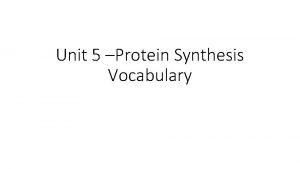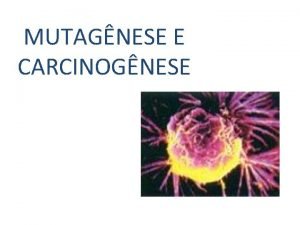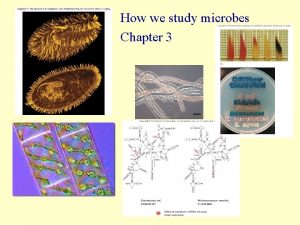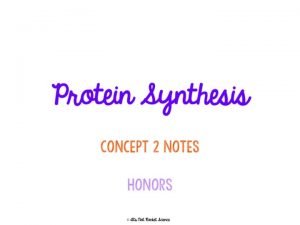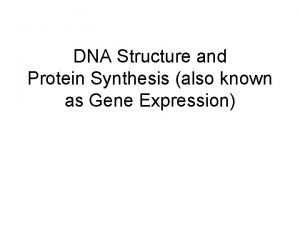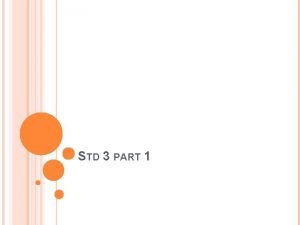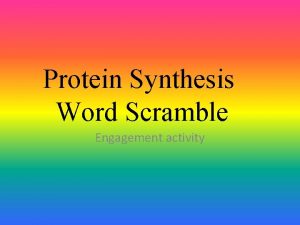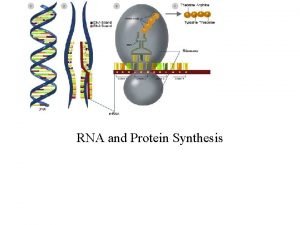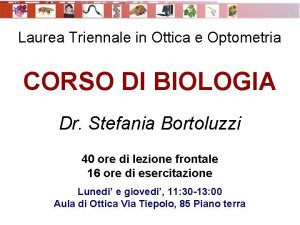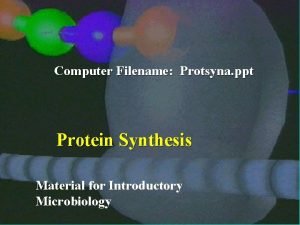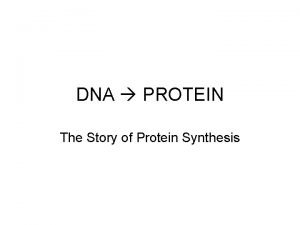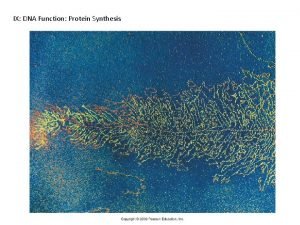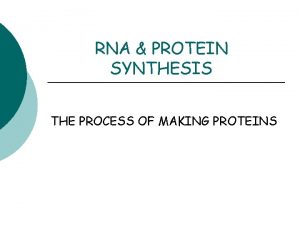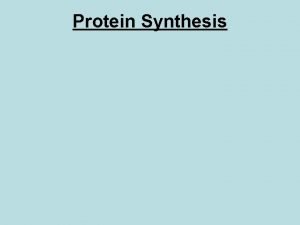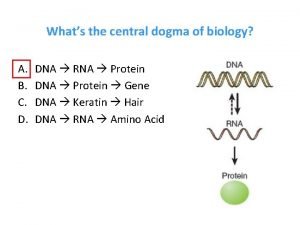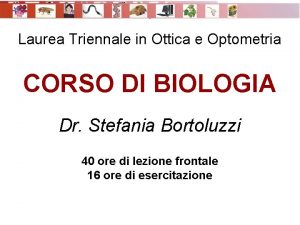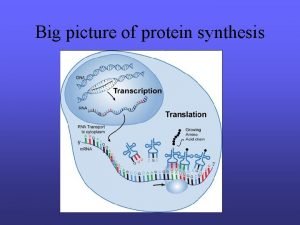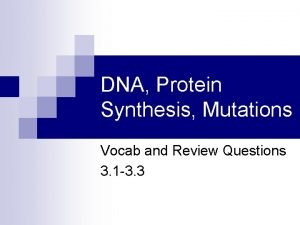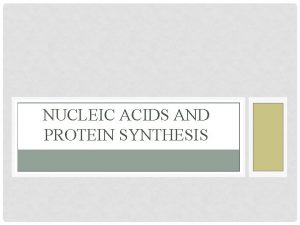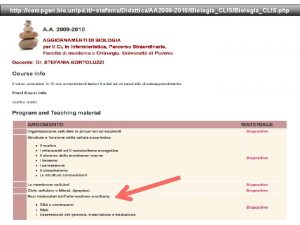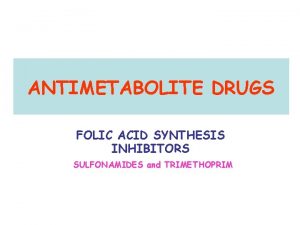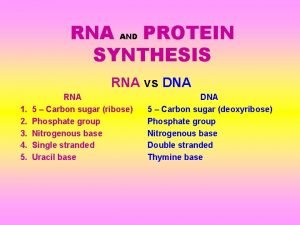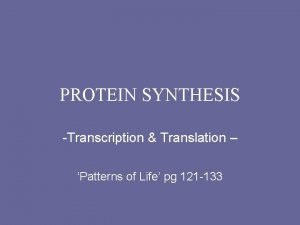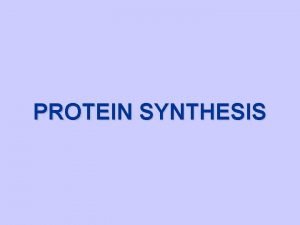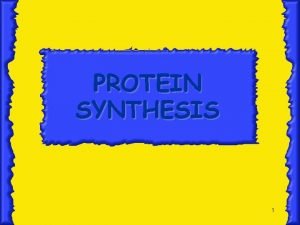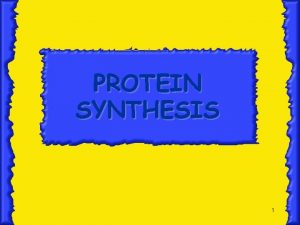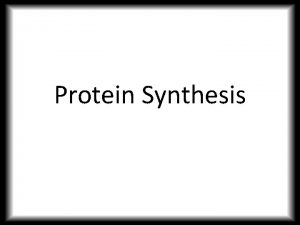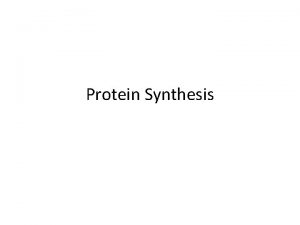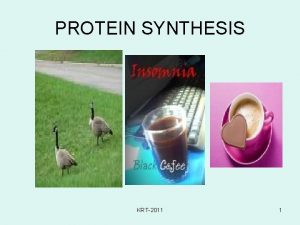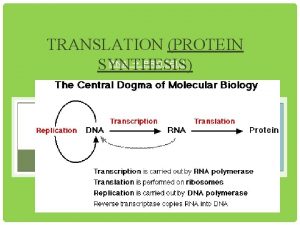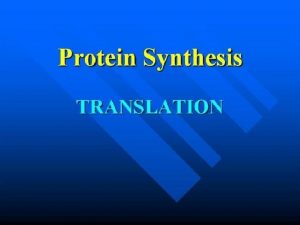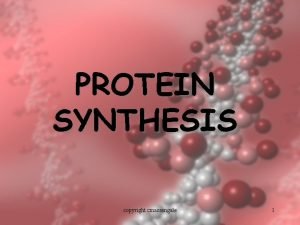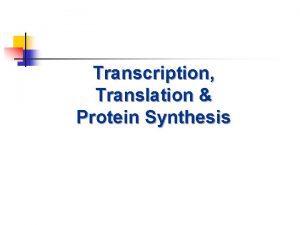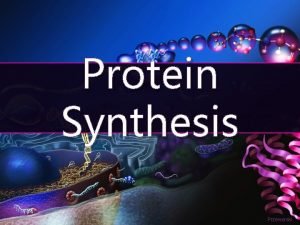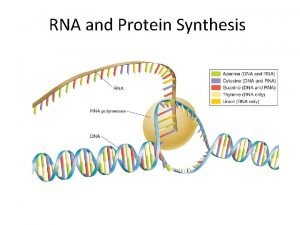PROTEIN SYNTHESIS 1 Protein Synthesis The production synthesis

















































- Slides: 49

PROTEIN SYNTHESIS 1

Protein Synthesis § The production (synthesis) of polypeptide chains (proteins) § Two phases: Transcription & Translation § m. RNA must be processed before it leaves the nucleus of eukaryotic cells 2

DNA RNA Protein DNA Transcription m. RNA Ribosome Translation Protein Prokaryotic Cell 3

DNA RNA Protein Nuclear membrane DNA Transcription Eukaryotic Cell Pre-m. RNA Processing m. RNA Ribosome Translation Protein 4

Pathway to Making a Protein DNA m. RNA t. RNA (ribosomes) Protein 5

DNA Replication 6

Steps in DNA Replication Occurs when chromosomes duplicate (make copies) An exact copy of the DNA is produced with the aid of the enzyme DNA polymerase Hydrogen bonds between bases break and enzymes “unzip” the molecule Each old strand of nucleotides serves as a template for each new strand New nucleotides move into complementary positions are joined by DNA polymerase 7

Two New, Identical DNA Strands Result from Replication 8

Another View of Replication 9

RNA 10

RNA Differs from DNA 1. RNA DNA 2. RNA DNA 3. RNA DNA has a sugar ribose has a sugar deoxyribose contains the base uracil (U) has thymine (T) molecule is single-stranded is double-stranded 11

Structure of RNA 12

. Three Types of RNA • Messenger RNA (m. RNA) carries genetic information to the ribosomes • Ribosomal RNA (r. RNA), along with protein, makes up the ribosomes • Transfer RNA (t. RNA) transfers amino acids to the ribosomes where proteins are synthesized 13

Making a Protein 14

Genes & Proteins § Proteins are made of amino acids linked together by peptide bonds § 20 different amino acids exist § Amino acids chains are called polypeptides § Segment of DNA that codes for the amino acid sequence in a protein are called genes 15

Two Parts of Protein Synthesis § Transcription makes an RNA molecule complementary to a portion of DNA § Translation occurs when the sequence of bases of m. RNA DIRECTS the sequence of amino acids in a polypeptide 16

Genetic Code § DNA contains a triplet code § Every three bases on DNA stands for ONE amino acid § Each three-letter unit on m. RNA is called a codon § Most amino acids have more than one codon! § There are 20 amino acids with a possible 64 different triplets § The code is nearly universal among living organisms 17

18

Transcription Translation 19

Overview of Transcription § During transcription in the nucleus, a segment of DNA unwinds and unzips, and the DNA serves as a template for m. RNA formation § RNA polymerase joins the RNA nucleotides so that the codons in m. RNA are complementary to the triplet code in DNA 20

Steps in Transcription § The transfer of information in the nucleus from a DNA molecule to an RNA molecule § Only 1 DNA strand serves as the template § Starts at promoter DNA (TATA box) § Ends at terminator DNA (stop) § When complete, pre-RNA molecule is released 21

Transcription 22

23

What is the enzyme responsible for the production of the m. RNA molecule? 24

RNA Polymerase § Enzyme found in the nucleus § Separates the two DNA strands by breaking the hydrogen bonds between the bases § Then moves along one of the DNA strands and links RNA nucleotides together 25

DNA RNA Polymerase pre-m. RNA 26

Question: § What would be the complementary RNA strand for the following DNA sequence? DNA 5’-GCGTATG-3’ 27

Answer: • DNA 5’-GCGTATG-3’ • RNA 3’-CGCAUAC-5’ 28

Processing Pre-m. RNA • Also occurs in the nucleus • Pre-m. RNA made up of segments called introns & exons • Exons code for proteins, while introns do NOT! • Introns spliced out by splicesomeenzyme and exons re-join • End product is a mature RNA molecule that leaves the nucleus to the cytoplasm 29

RNA Processing pre-RNA molecule exon intron exon splicesome exon Mature RNA molecule 30

Messenger RNA (m. RNA) • Carries the information for a specific protein • Made up of 500 to 1000 nucleotides long • Sequence of 3 bases called codon • AUG – methionine or start codon • UAA, UAG, or UGA – stop codons 31

Messenger RNA (m. RNA) start codon m. RNA A U G G G C U C C A U C G G C A U A A codon 1 protein methionine codon 2 codon 3 glycine serine codon 4 isoleucine codon 5 codon 6 glycine alanine codon 7 stop codon Primary structure of a protein aa 1 aa 2 aa 3 peptide bonds aa 4 aa 5 aa 6 32

Transfer RNA (t. RNA) • Made up of 75 to 80 nucleotides long • Picks up the appropriate amino acid floating in the cytoplasm • Transports amino acids to the m. RNA • Have anticodons that are complementary to m. RNA codons • Recognizes the appropriate codons on the m. RNA and bonds to them with H -bonds 33

Transfer RNA (t. RNA) amino acid attachment site methionine amino acid U A C anticodon 34

Ribosomal RNA (r. RNA) • Made up of r. RNA is 100 to 3000 nucleotides long • Made inside the nucleus of a cell • Associates with proteins to form ribosomes 35

Ribosomes • Made of a large and small subunit • Composed of r. RNA (40%) and proteins (60%) • Have two sites for t. RNA attachment --- P and A 36

Ribosomes Large subunit P Site A Site m. RNA Small subunit A U G C U A C U U C G 37

Translation • Synthesis of proteins in the cytoplasm • Involves the following: 1. m. RNA (codons) 2. t. RNA (anticodons) 3. ribosomes 4. amino acids 38

Translation • Three steps: 1. initiation: start codon (AUG) 2. elongation: amino acids linked 3. termination: stop codon (UAG, UAA, or UGA). Let’s Make a Protein ! 39

m. RNA Codons Join the Ribosome Large subunit P Site A Site m. RNA A U G Small subunit C U A C U U C G 40

Initiation aa 1 1 -t. RNA anticodon hydrogen bonds U A C A U G codon aa 2 2 -t. RNA G A U C U A C U U C G A m. RNA 41

Elongation peptide bond aa 1 aa 3 aa 2 3 -t. RNA 1 -t. RNA anticodon hydrogen bonds U A C A U G codon 2 -t. RNA G A U C U A C U U C G A m. RNA 42

aa 1 peptide bond aa 3 aa 2 1 -t. RNA 3 -t. RNA U A C (leaves) 2 -t. RNA A U G G A A G A U C U A C U U C G A m. RNA Ribosomes move over one codon 43

aa 1 peptide bonds aa 2 aa 4 aa 3 4 -t. RNA 2 -t. RNA A U G 3 -t. RNA G C U G A A C U U C G A A C U m. RNA 44

aa 1 peptide bonds aa 4 aa 2 aa 3 2 -t. RNA 4 -t. RNA G A U (leaves) 3 -t. RNA A U G G C U G A A C U U C G A A C U m. RNA Ribosomes move over one codon 45

aa 1 peptide bonds aa 5 aa 2 aa 3 aa 4 5 -t. RNA U G A 3 -t. RNA 4 -t. RNA G A A G C U A C U U C G A A C U m. RNA 46

peptide bonds aa 1 aa 5 aa 2 aa 3 aa 4 5 -t. RNA U G A 3 -t. RNA G A A 4 -t. RNA G C U A C U U C G A A C U m. RNA Ribosomes move over one codon 47

aa 4 aa 5 Termination aa 199 aa 3 primary structure aa 2 of a protein aa 200 aa 1 200 -t. RNA A C U terminator or stop codon C A U G U U U A G m. RNA 48

End Product –The Protein! • The end products of protein synthesis is a primary structure of a protein • A sequence of amino acid bonded together by peptide bonds aa 2 aa 1 aa 3 aa 4 aa 5 aa 199 aa 200 49
 Multimedia content production adalah
Multimedia content production adalah Carrier vs channel proteins
Carrier vs channel proteins Protein-protein docking
Protein-protein docking Building vocabulary: protein production
Building vocabulary: protein production Teste de ames
Teste de ames Ribosome
Ribosome Protein synthesis
Protein synthesis Rna and protein synthesis study guide
Rna and protein synthesis study guide Protein synthesis restaurant analogy
Protein synthesis restaurant analogy Double stranded dna
Double stranded dna Which best summarizes the process of protein synthesis?
Which best summarizes the process of protein synthesis? Protein synthesis scramble
Protein synthesis scramble Molecular genetics
Molecular genetics Dna cookbook analogy
Dna cookbook analogy Totipotent cells
Totipotent cells Section 12 3 rna and protein synthesis
Section 12 3 rna and protein synthesis Sintese de proteinas na celula
Sintese de proteinas na celula Protein synthesis ppt
Protein synthesis ppt Synthesis
Synthesis Protein synthesis splicing
Protein synthesis splicing Catalytic functions
Catalytic functions Concept map of protein synthesis
Concept map of protein synthesis Protein synthesis
Protein synthesis Translate
Translate Elongation
Elongation Protein synthesis
Protein synthesis Section 12 3 rna and protein synthesis
Section 12 3 rna and protein synthesis Protein synthesis
Protein synthesis Transcription and translation picture
Transcription and translation picture Protein synthesis and mutations
Protein synthesis and mutations Bbc bitesize protein synthesis
Bbc bitesize protein synthesis Venn diagram of dna and rna
Venn diagram of dna and rna Nucleic acid made up of
Nucleic acid made up of Ribonucleic acid
Ribonucleic acid Protein synthesis
Protein synthesis Protein synthesis and mutations
Protein synthesis and mutations Order of bases in dna
Order of bases in dna Protein synthesis
Protein synthesis Sulfonamides mechanism of action
Sulfonamides mechanism of action Protein synthesis
Protein synthesis Protein synthesis animation mcgraw hill
Protein synthesis animation mcgraw hill Protein synthesis and mutations
Protein synthesis and mutations Dna and genes chapter 11
Dna and genes chapter 11 Cong thức tính động năng
Cong thức tính động năng Tỉ lệ cơ thể trẻ em
Tỉ lệ cơ thể trẻ em Thế nào là mạng điện lắp đặt kiểu nổi
Thế nào là mạng điện lắp đặt kiểu nổi Dot
Dot Lời thề hippocrates
Lời thề hippocrates Vẽ hình chiếu đứng bằng cạnh của vật thể
Vẽ hình chiếu đứng bằng cạnh của vật thể độ dài liên kết
độ dài liên kết



